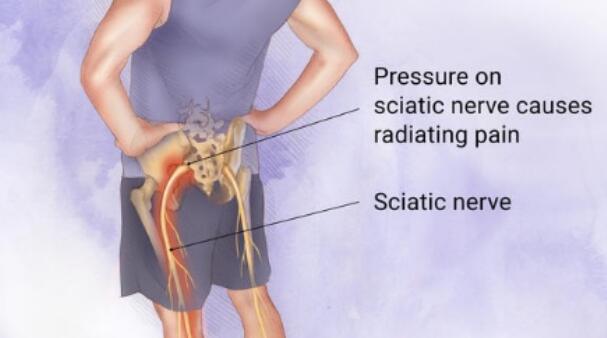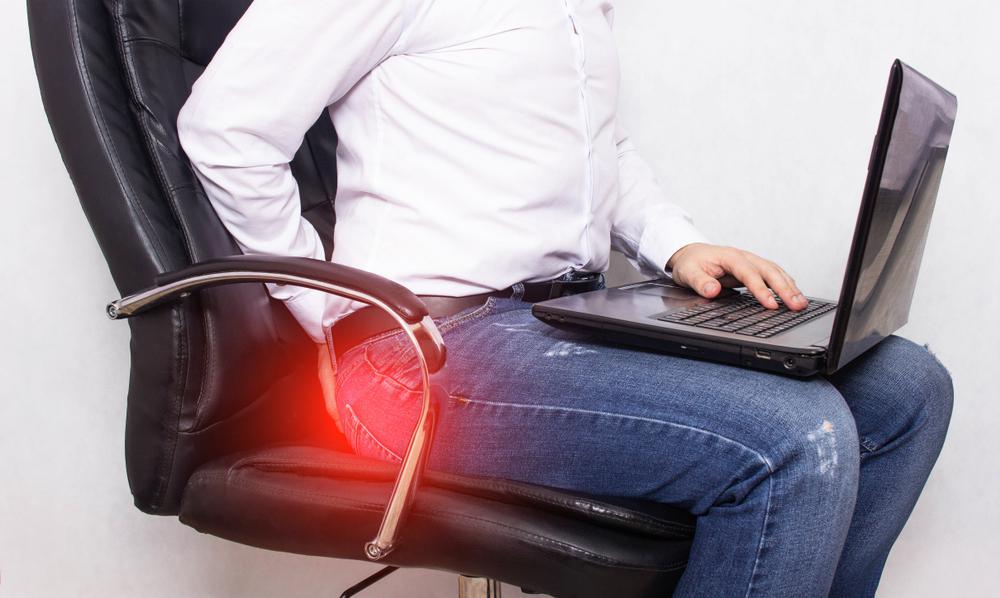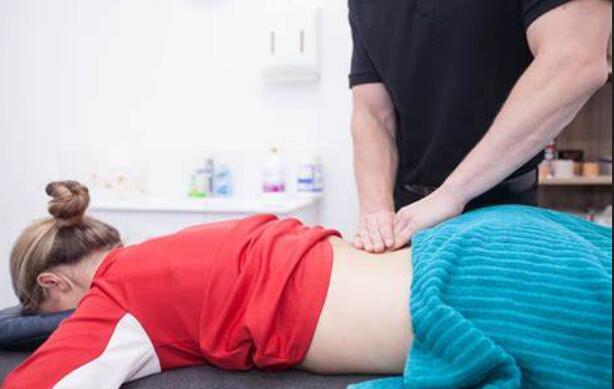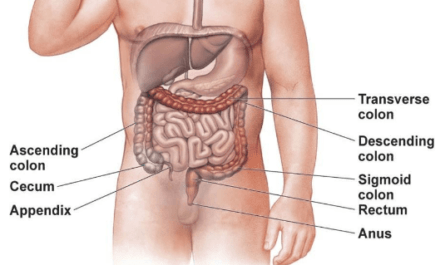Sciatic nerve pain can be a daunting medical condition to experience and deal with. It is a sharp, shooting pain that can start in the lower back and radiate through the hips and buttocks. Sometimes it may extend down the back of the leg.
Sciatic nerve pain can be so severe that it can even make it difficult to move around and leave you bedridden for days. Fortunately, various treatments are available for sciatic nerve pain, from medications to natural remedies, and many of these treatments can help you find relief from your symptoms. This article will discuss ten easy ways to ease sciatic nerve pain quickly.

What is Sciatic Nerve Pain?
Sciatic nerve pain is characterized by pain in the lower back, including the hips, buttocks, and sometimes down the legs.
Injury directly to the sciatic nerve is not very common, but the pain in the lower back radiating down to the legs is termed sciatic nerve pain.
In some cases, sciatica affects just one side of the body and is caused by a herniated disk or another condition which causes the nerve to be compressed. When these things happen, it leads to pain, inflammation of the nerves, and sometimes, numbness in one leg.
When asked to describe their experiences with sciatica pain, a range of words is used to explain the pain, including “stabbing” and “electric.”
It has also been described as an inconsistent pain, which sometimes eases up, and other times intensifies. The pain might be worsened by specific sharp or sudden movements, such as twisting your upper body in a stretch or a hard cough.
Most cases of sciatica can be managed at home with some prescribed painkillers, but people with a more advanced form of sciatic nerve pain might need to be scheduled for surgery. This is significantly more so if the sciatica is so severe that it has affected their mobility and bladder.

Common Symptoms of Sciatica Pain
- Pain in the lower back, hips, buttocks, and down the legs.
- Numbness in the lower back, buttocks, legs, or feet.
- Pain triggered by sudden movements.
- Tingling sensation in the feet and legs.
- Bladder and bowel impairment.
What Causes Sciatica Nerve Pain?
The sciatic nerve is located in the lower parts of the spine, and when there is an irritation, compression, or inflammation in that area due to one reason or the other, it leads to the pain known as sciatica nerve pain. One of the most common causes of this pain is a slipped disk, which affects the nerve root.
Studies have shown that in the United States, an estimated 1%-5% of people will suffer from a slipped disk during their lifetime. When pressure is applied to the spine due to one reason or the other, it can lead to a slipped or inflamed disk, ultimately leading to sciatic nerve pain.
Another cause of sciatica is degenerative disk disease. The disks cushioning the vertebra weaken and flatten, reducing the height of the disks. This translates into the nerve passageway becoming much narrower. And the sciatic nerve root might be more exposed to injury.
When osteoarthritis occurs, bones’ jagged edges form, which can compress the nerves in the lower back.
Other sciatica causes include tumors, trauma due to some injury, spondylolisthesis, piriformis, and equine cauda syndrome.
Sciatic Nerve Pain During Pregnancy
Sciatic nerve pain may also occur during pregnancy, especially in the third trimester. The developing baby will put pressure on the nerve and cause pain in the back of the thigh or lower part of the leg. This pain usually appears on just one side.
The best way to relieve sciatic nerve pain during pregnancy is to lie on your side, which is the opposite of the pain. This remedy will help ease the pressure on the nerve. If the pain increases in severity or becomes constant, seek medical help as soon as possible.
Diagnosis
Even with the availability of articles and websites offering information on sciatica nerve pain, you should visit your healthcare provider for a proper diagnosis.
The physical check examines how well your spine stands against the weight placed on it. Also, the healthcare provider will look at your calf and leg muscles by asking you to stand on your toes.
Other tests include the strength leg raise test and other motions to help determine your muscle strength and flexibility.
After the physical examinations, depending on the findings of your healthcare provider, you might be directed to perform further scans such as:
- Spinal X-rays
- Nerve conduction velocity studies
- Magnetic Resonance Imaging (MRI) or Computed Tomography (CT) scans.
- Myelogram

Ten ways to Ease Sciatic Nerve Pain
Sciatic nerves are located in the lower area of the spinal cord and stretch down the buttocks to just below the knees. These nerves can cause pain when trauma, inflammation, or a slipped disk is involved. The pain can vary in magnitude and sometimes need professional treatment.
1. Take walks
If you are experiencing mild to moderate pains, it is a good idea to keep moving by going on short walks or engaging in physical activities that you can handle. Make sure your movements affect your lower back area, where the pain originates.
2. Alternate Between Heat and Cold
Applying heat and cold to your affected areas might help ease the pain. Doctors always recommend using cold for an injury that has just happened and switching to heat after 72 hours. Try a heating pad, but don’t allow it to burn your skin, and then switch to an ice pack after around 20 minutes.
3. Use Painkillers
Over-the-counter painkillers, such as Ibuprofen and Diclofenac, are available to help you relieve your pain. Follow the dosage on the bottle or your doctor gives you.
4. Acupuncture
The Western world is starting to open up more to medicine and treatments from the Chinese. Acupuncture is found to be extremely helpful in relieving pain, including sciatica.
Some have even said that acupuncture works better than some modern painkillers. The important thing is that you find licensed professionals who know what they are doing.
5. Yoga
Any physical activity goes a long way in helping to relieve sciatica. Even though it would not be a permanent cure, yoga would help ease your pains. You can try Iyengar yoga, which corrects the posture and allows you to move more quickly.
6. Prescription Medication
If some over-the-counter and home remedies do not help ease your sciatic nerve pain, you might need to see a doctor and get some prescribed painkillers.
There are more than a handful of strong NSAIDs and muscle relaxers that will ease up your pain.
7. See a Physical Therapist
With proper physical therapy, you should be able to correct the poor posture, which could be causing your sciatica, and even help build up and strengthen the muscles in your lower back that might be worn down.
With the help of your therapist, you should be able to draw up a suitable exercise routine. Following the program carefully and with the guidance of your physical therapist, you should see a significant improvement in your condition.
8. Massage
Many think getting a massage is about self-indulgence, pampering, and relaxation. However, some studies have shown that a good massage from a professional can significantly ease sciatica nerve pain and improve movement in the lower back and other affected areas.
Massages aim at helping in blood circulation and relaxing the muscles. These two things are essential in managing sciatic nerve pain. Look out for a masseuse or therapist dealing with back pain.
9. Epidurals
This might seem like a drastic relief method, but if you can’t ease your sciatic nerve pain through any other means listed, you might need to turn to get an epidural.
Of course, this can only be administered after your doctor thoroughly examined you and ruled out any other treatment for your sciatica. The shot of steroids will be injected directly into your spine.
In most cases, you are only eligible for a shot epidural if you have been in pain for at least six months with no relief. Ensure you do your findings on the pros and cons of getting an epidural and the best treatment.
10. Stretches
Movement is beneficial in easing sciatic nerve pain, so engaging in some of these stretches is advisable. After around 4-6 weeks, you should register some improvements in your pain.
Knee Chest Stretch
Begin this exercise in a lying-down position. Next, elevate your head slightly with a small pillow or a book. Then, bend your knees towards your chest, with your feet straight and your hips width apart. Hold your knee to your wardrobe for at least 20 seconds. Alternate between both legs.
Anaconda stretch
This stretch is aptly named since you will stretch your body in a posture mimicking the snake. Begin this stretch by lying down flat on your stomach. Next, extend your upper body with your elbows bent at the side, bearing your weight. Look down and hold your neck straight. You should feel the burn of the stretch in your stomach and lower back area. Hold the posture for at least 10 seconds.
Sciatic mobilizing stretch
Place a small pillow or cushion under your head, and lie flat on your back. Next, bend one knee with your feet flat on the ground, and raise the other leg into the air. Keep your upper body straight, and turn the raised leg towards your chest. Hold the bent leg down to your wardrobe for some time, and straighten it again. Hold the pose for 30 seconds, and repeat.
Standing Hamstring Stretch
Stand upright, and raise one leg on an elevated object, such as a step. Keep that leg as straight as you can, and lean forward, holding your back straight. Stay in this position for 30 seconds, taking slow, deep breaths. Alternate between both legs.
Lying Deep Gluteal Stretch
Start this stretch flat on your back, with a small book or cushion under your head. Bend your left leg firmly on the ground, and rest your right foot across your left thigh.
Make sure your hips stay straight and your lower back firmly on the ground, wrap your hands behind your left thigh, and pull them towards you. Hold the pose for 20-30 seconds, and feel the burn in your right buttock. Repeat the exercise for both legs.
Knee to Opposite Shoulder
This simple stretch focuses on your piriformis and gluteal muscles, which will go a long way in easing your sciatica pain. Lie flat on your back, bring your left knee up towards your left shoulder, and wrap your hands around the knee to hold it.
Hold this position for 30 seconds, ensuring that you apply just the right amount of pressure and not too much to make yourself uncomfortable. Release your leg, and repeat the movements on the second leg.
If you do not see any significant improvement in your condition after a couple of weeks of going through the exercises or feeling increased pain in the area, you should consult your doctor.
Final Words
Although Sciatic nerve pain can be painful and inconvenient, it is not usually dangerous. If symptoms escalate to the extent you have a fever, you find blood in your urine, or inconsistencies with your bowel and bladder control; you should immediately speak with a health care provider.






